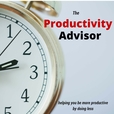
Summary: <br> How to Increase Productivity<br> Do you want to know how to increase productivity?<br> One very simple way is to stop multitasking, but before you do that let me ask you two questions;<br> Doesn’t it feel great to be doing several things at once?<br> Don’t you feel like you are getting more done?<br> Well you may feel like you are getting more done but the science shows you most probably are not. Multitasking does feel good. It switches on the happy receptors in our brain. However, it’s definitely not the most productive or efficient way to work.<br> <br> Infact research shows it's the least effective way to get more done!<br> <br> The problem is to do with “switching time”. That’s the amount of time your brain needs to change tasks. Sometimes this can be seconds, sometimes this can be minutes. One study found that respondents needed 20 minutes to get back into their focussed working after being disturbed by a phone call for example.<br> <br> So while we are busting myths let’s bust the one that says women are better at multitasking than men. They are. That’s because women need less time to “switch” between tasks than men.<br> However, multitasking is still not productive overall. That’s because it’s requires lots of energy. The brain uses more energy than the rest of our body and by changing tasks frequently we are making our brains work very hard. That’s why we are often left feeling strained and tired after extended periods of multitasking.<br> Multitasking can also lead to mistakes and errors<br> How many times have you had to go back over something and correct it because you didn’t give it your full attention first time for example?<br> In an age where we are under increasing pressure to do more and more multitasking seems like a great answer – just do more things at the same time to get everything done.<br> However, if you want to be effective at work, complete more tasks right first time, do your best work and avoid feeling “frazzled” then you need to move away from multitasking and move to single tasking.<br> Single tasking is a great time management technique, helping you to become more productive at work and also be more effective.<br> The hardest thing about this technique is giving up the happy feeling that we get when we multitask.<br> This technique also requires constant vigilance – it’s easy to relapse and before you know it you are checking emails whilst on the phone and not paying attention to either.<br> <br> Here's how to move from multitasking to single tasking;<br> <br> <br> <br> Look at your schedule and see if you can slot in some time for working on one thing at a time – single tasking.<br> <br> <br> Notice how this feels and build on that experience.<br> <br> <br> Monitor your multitasking and aim to reduce it gradually until it’s at a minimum.<br> <br> <br> Be realistic – this is not a technique you can employ overnight.<br> <br> <br> <br>
